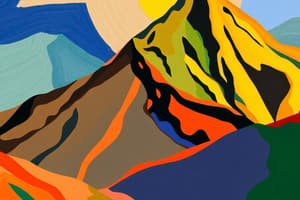Podcast
Questions and Answers
What is the main factor that contributes to the formation of mountains?
What is the main factor that contributes to the formation of mountains?
- Sedimentary processes
- Weathering
- Tectonic forces (correct)
- Erosion
Which of the following mountain ranges is located in Europe?
Which of the following mountain ranges is located in Europe?
- Alps (correct)
- Himalayas
- Rocky Mountains
- Andes
Plains are characterized by:
Plains are characterized by:
- Tectonic activity
- Extensive forests
- Flat and level expanses of land (correct)
- High hills and ridges
Which process can contribute to the formation of valleys?
Which process can contribute to the formation of valleys?
Plateaus are distinctive landforms characterized by their:
Plateaus are distinctive landforms characterized by their:
Flashcards are hidden until you start studying
Study Notes
Introduction to Geography
Geography is the scientific study of the earth's lands, features, plants, animals, and people. It covers various aspects of the physical and human world, including the location, characteristics, and interrelationships of these components. Geographers investigate the relations between places and the relationships between people and their environments. Their work provides valuable insights into the complexities and dynamics of our planet, shaping our understanding of the world and our place within it.
Mountains
Mountains are massive landforms that rise dramatically above surrounding land levels, typically formed through tectonic forces. They often host unique ecosystems and play significant roles in influencing weather patterns. Mountain ranges occur all over the world, including the Alps in Europe, the Andes in South America, and the Rocky Mountains in North America.
Plains
Plains are flat and level expanses of land with few hills or ridges. They can vary widely in size and composition, ranging from vast grasslands to fertile agricultural areas. Plains can be formed by sedimentary processes, erosion, or tectonic activity. Examples of plains include the Great Plains of North America, the Eurasian Steppe, and the Australian Outback.
Valleys
Valleys are low-lying depressions surrounded by higher land. They can form due to erosion, tectonic activity, or the deposition of sediments. Valleys often support diverse ecosystems and are crucial for agriculture, as they offer relatively flat and accessible terrain for farming. Notable examples include the Amazon Rainforest valley in South America and the San Joaquin Valley in California.
Plateaus
Plateaus are broad, flat-topped landforms that rise abruptly from the surrounding land on at least one side. They can form through volcanic activity, tectonic movements, or the accumulation of sedimentary rocks. Plateaus often host distinct ecosystems and serve as important sources of resources, such as minerals and water. Examples of plateaus include the Tibetan Plateau, the Colorado Plateau, and the Deccan Plateau in India.
Studying That Suits You
Use AI to generate personalized quizzes and flashcards to suit your learning preferences.





